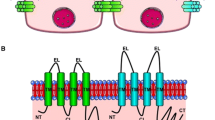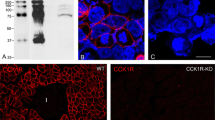Summary
The paracellular conducting pathway of theNecturus gallbladder was studied with electrophysiological and electromicroscopic methods. The first one consists of the passage of short (5 msec) and small (32 μA cm−2) current pulses associated with a voltage scanning of the plane of the epithelium at the apical surface with a microelectrode to detect the regions where current flows. The procedure shows that (a) the conductance is evenly distributed along the intercellular regions along the intercellular spaces of the cells where occluding junctions are located; (b) the field above the occluding junctions has the shape of a bell, so that the junction can be sensed at 1–2 μm from the region where the intercellular space is visualized by light microscopy; (c) the intersections between three cells, in spite of having 3 half-junctions contributing (instead of two), do not have a higher conductance than the rest of the occluding junction. Scanning electron microscopy shows that (a) cells are densely covered by microvilli which interdigitate above the region of the occluding junctions, and (b) are covered by a surface coat. With transmission electron microscopy, (a) the opening of the occluding junctions at the apical border appears irregular, and most of them oblique; (b) in the last microns the actual mouth of the junction may deviate from the course of the interspace. Freeze-fracture replicas indicate that (a) the occluding junction has a uniform width and little variations in the number of strands around the cell, except (b) at intersections between 3 cells where both, its width and the number of strands, increase toward the basal region.
Similar content being viewed by others
References
Bentzel, C.J., Hainau, B., Ho, S., Hui, S.W., Edelman, A., Anagnostopoulos, T., Benedetti, E.L. 1980. Cytoplasmic regulation of tight-junctions permeability: Effect of plant cytokinins.Am. J. Physiol. 239:C75-C89
Bindslev, N., Tormey, J. Mcd., Wright, E.M. 1974. The effects of electrical and osmotic gradients on lateral intercellular spaces and membrane conductance in a low resistance epithelium.J. Membrane. Biol. 19:357–380
Cereijido, M., Meza, I., Martínez-Palomo, A. 1981. Occluding junctions in cultured epithelial monolayers.Am. J. Physiol. 240:C96-C102
Cereijido, M., robbins, E.S., Dolan, W.J., Rotunno, C.A., Sabatini, D.D. 1978. Polarized monolayers formed by epithelial cells on a permeable and transluscent support.J. Cell Biol. 77:853–880
Cereijido, M., Stefani, E., Martínez-Palomo, A. 1980. Occluding junctions in a cultured transporting epithelium: Structural and functional heterogeneity.J. Membrane Biol. 53:19–32
Clarkson, T.W. 1967. The transport of salt and water across isolated rat ileum. Evidence for at least two distinct pathways.J. Gen. Physiol. 50:695–727
Claude, P. 1978. Morphological factors influencing transpeithelial permeability: A model for the resistance of the zonula occludens.J. Membrane Biol. 39:219–232
Claude, P., Goodenough, D.A. 1973. Fracture faces of zonulae occludentes from “tight” and “leaky” epithelia.J. Cell Biol. 58:390–400
Friend, D.S., Gilula, N.B. 1972. Variations in tight and gap junctions in mammalian tissues.J. Cell Biol. 53:758–776
Frömter, E. 1972. The route of passive ion movement through the epithelium ofNecturus gallbladder.J. Membrane Biol. 8:259–301
Frömter, E., Diamond, J. 1972. Route of passive ion permeation in epithelia.Nature, New Biol. 235:9–14
Kühn, K., Reale, E. 1975. Junctional complexes of the tubular cells in the human kidney as revealed with freeze-fracture.Cell Tissue Res. 160:193–205
Martínez-Palomo, A., Chávez, B., González-Robles, A. 1978. The freeze-fracture technique: Applications to the study of animal plasma membranes.In Electron Microscopy, Vol. 3. State of the Art Symposia. J.M. Sturgess (editor). pp. 503–515 Micros. Society of Canada Toronto
Martínez-Palomo, A., Erlij, D. 1975. Structure of tight junctions in epithelia with different permeability.Proc. Natl. Acad. Sci. USA 72:4487–4491
Martínez-Palomo, A., Meza, I., Beaty, G., Cereijido, M. 1980. Experimental modulation of occluding junctions in a cultured transport epithelium.J. Cell Biol. 87:736–745
Meza, I., Ibarra, G., Sabanero, M., Martínez-Palomo, A., Cereijido, M. 1980. Occluding junctions and cytoskeletal components in a cultured transporting epithelium.J. Cell. Biol. 87:746–754
Misfeldt, D.S., Hamamoto, S.T., Pitelka, D.K. 1976. Transepithelial transport in cell culture.Proc. Natl. Acad. Sci. USA 73:1212–1216
Moreno, J.H., Diamond, J.M. 1974. Discrimination of monovalent inorganic cations by “tight” junctions of gallbladder epithelium.J. Membrane Biol. 15:277–318
Pricam, C., Humbert, F., Perrelet, A., Orci, L. 1974. A freezeetch study of the tight junctions of the rat kidney tubules.Lab. Invest. 30:286–291
Reuss, L. 1978. Transport in gallbladder.In: Membrane Transport in Biology. G. Giebisch, D.C. Tosteson, and H.H. Ussing, editors. Ch. 17, Pt. IV. A and B Transport Organs. Springer-Verlag, Berlin, Heidelberg, New York
Reuss, L., Cheung, L.Y., Grady, T.P. 1981. Mechanism of cation permeation across apical cell membrane ofNecturus gallbladder: Effects of luminal pH and divalent cations on K+ and Na+ permeability.J. Membrane Biol 59:211–224
Reuss, L., Finn, A.L. 1977. Effects of luminal hyperosmolarity on electrical pathways ofNecturus gallbladder.Am. J. Physiol. 232:C99-C108
Smulders, A.P., Tormey, J. McD., Wright, E.M. 1972. The effect of osmotically induced water flows on the permeability and ultrastructure of the rabbit gallbladder.J. Membrane Biol. 7:164–197
Staehelin, L.A. 1973. Further observations on the fine structure of freeze-cleaved tight junctions.J. Cell Sci. 13:763–786
Staehelin, L.A., Mukherjee, T.M., Williams, A.W. 1969. Freeze-etch appearance of tight junctions in the epithelium of small and large intestine of mice.Protoplasma 67:165–184
Wiedner, G., Wright, E.M. 1975. The role of the lateral intercellular spaces in the control of ion permeation across the rabbit gallbladder.Pfluegers Arch. 358:27–40
Wright, E.M., Barry, P.H., Diamond, J. 1971. The mechanism of cation permeation in rabbit gallbladder.J. Membrane Biol. 4:331–357
Wright, E.M., Diamond, J.M. 1968. Effect of pH and polyvalent cations on the selective permeability of gallbladder epithelium to monovalent ions.Biochim. Biophys. Acta 163:57–74
Wright, E.M., Smulders, A.P., Tormey, J. McD. 1972. The role of the lateral intercellular spaces and solute polarization effects in the pssive flow of water across the rabbit gallbladder.J. Membrane. Biol. 7:198–219
Author information
Authors and Affiliations
Rights and permissions
About this article
Cite this article
Cereijido, M., Stefani, E. & Chávez de Ramírez, B. Occluding junctions of theNecturus gallbladder. J. Membrain Biol. 70, 15–25 (1982). https://doi.org/10.1007/BF01871585
Received:
Revised:
Issue Date:
DOI: https://doi.org/10.1007/BF01871585




